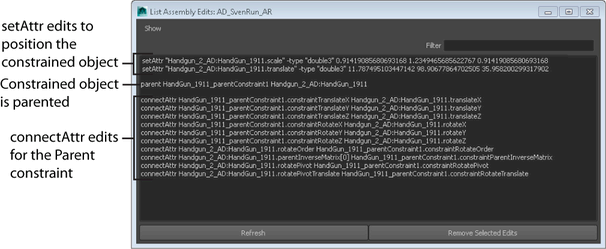When you create a constraint on assembly reference nodes or assembly reference members, an add connection edit and parenting edit are applied to the objects. Depending on the type of constraint you create, more than one connection edit may be applied to the objects.

As with other Scene Assembly edits, when the assembly reference node or assembly reference member is unloaded from the scene, the edit not longer applies. When an assembly reference member is the constrained object and it is unloaded, a fosterParent node is created as a place holder for the unloaded assembly reference member. See Switching constrained representations.
When the constraint connection edit is removed, by selecting it in the List Assembly Edits window and clicking Remove Selected Edits for example, the constraint node remains in the scene
An assembly reference member object can be the target of any number of constraints. For example, an assemblyReference node can be the target of two Point and one Orientation constraints at the same time. An assembly reference member object can be constrained to one target object for each type of constraint. For example, an object contained by a Scene representation can only be Point constrained by one target object at one time. It can be simultaneously Point and Orient constrained.
 Except where otherwise noted, this work is licensed under a Creative Commons Attribution-NonCommercial-ShareAlike 3.0 Unported License
Except where otherwise noted, this work is licensed under a Creative Commons Attribution-NonCommercial-ShareAlike 3.0 Unported License